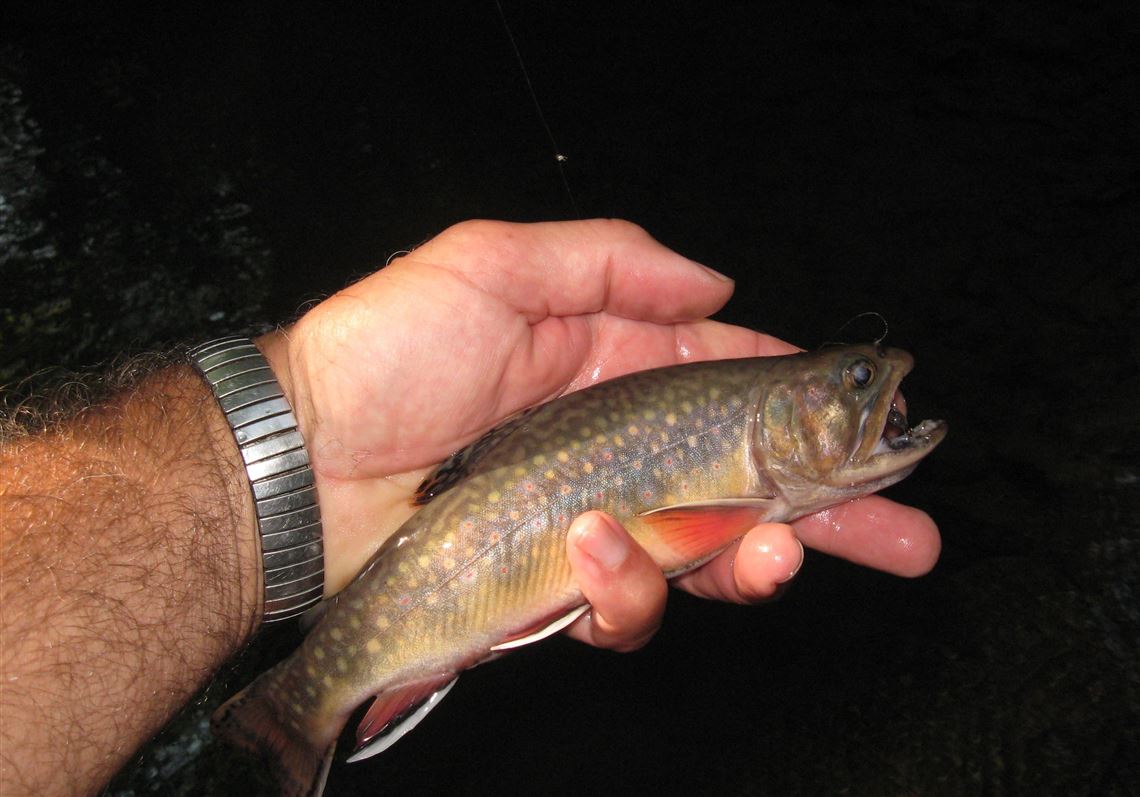Fishermen tend to assume that “a fish is a fish” and except for size, one fish is much like another. That view may be reinforced by our dependence on hatchery stock to support trout fishing. To produce trout economically in hatcheries, fish culturists select traits like survivability in confined raceways, tolerance of handling and rapid growth, so hatchery-reared trout show little variability, one from another. Their genetic traits fit a captive existence but may have little value in the wild.
Today, as hatchery fish become more expensive, and as interest in sustainable environments grows, fishery scientists are looking closer at wild trout populations to understand how these resilient fish survive in challenging settings. They’re learning there is more to a trout, especially a wild trout, than meets the angler’s eye.
“Genetic traits with survival value aren’t necessarily things that can be seen,” said Meredith Bartron, a geneticist with the U.S. Fish and Wildlife Service Northeast Fishery Center in Lamar, Pa. “Genetic markers that we are measuring aren’t visible but they’re important to the overall health of the population.
“Wild [trout] are important to study because they have persisted over time and recovered from impacts like deforestation, flood, drought or human activities,” Bartron continued. “The science of genetics is a tool we can use to learn how fisheries management can be employed to support them going forward.”
Across the eastern third of North America, including Pennsylvania, when scientists speak of wild trout they primarily mean wild brook trout. Heavy stocking of alien species continues -- especially rainbow and brown trout -- and browns sometimes reproduce after stocking. But the brook trout is the only salmonid species native to streams across Eastern Canada, the Great Lakes region, New England and the Appalachian Mountains.
Within Pennsylvania, wild brook trout are now mostly confined by pollution, urbanization, agriculture and competition from brown trout to more remote headwaters across the state’s northern tier and southward along the mountains. According to the Eastern Brook Trout Joint Venture, a collaboration of fisheries interests, brook trout occupy less than half of their original range in the state, and remaining populations are greatly reduced.
At the Wild Trout Summit convened in August in State College, researchers shared new insights gained through studying behavior and genetic diversity of selected brook trout populations in Pennsylvania streams. Those insights could help shape future management and environmental policy.
Scientists with the Pennsylvania Cooperative Fish and Wildlife Research Unit at Penn State University have been using radio-telemetry to track movements of brook trout in tributaries to Loyalsock Creek in Lycoming County, then analyzing sampled DNA.
“One of the things we’ve learned is that some trout are ‘movers’ and some are ‘stayers,’ ” said Tyler Wagner, assistant leader of Penn State’s Cooperative Fish and Wildlife Research Unit, and an adjunct professor of fisheries ecology. “Having both traits in populations favors the long-term resilience of brook trout as a species.”
Wagner explained that “stayer” trout maintain the species in established habitats, which is important to long-term species survival. But “movers” are equally important because these fish find new locations that offer a refuge if some force, like a flood or sudden pollution event, causes negative change in the original habitat. Wagner noted that although the studies indicate these are traits of individual fish, the behaviors complement one another in the survival and expansion of populations.
Penn State laboratory experiments mirror the field work. Shannon White, a doctoral candidate in Penn State’s ecology program, tested how individual brook trout navigate a maze to find food in a confined tank. White categorized the subjects as exhibiting “bold” or “shy” personalities which, in the wild, is expressed by “mover” or “stayer” behavior.
White takes blood and tissue samples to probe the link between genetics and “bold” or “shy” behavior in brook trout. That understanding would enable scientists and managers to determine if different subpopulations are exchanging genetic diversity through individuals on the move, enhancing each population’s resilience in the face of environmental change.
“A lot of genes influence personality and we don’t yet have a great understanding of how to predict personality in an individual fish. But we can look at the entire gene set of fish that are bold movers, then compare that set to other fish,” White said.
Fishermen, and often fisheries managers, have not always appreciated the importance of trout mobility — except in the loss of hatchery fish that dispersed away from their stocking point.
“This speaks to the importance of connectivity, to which there are many barriers out there that isolate brook trout populations,” Bartron said. “With brook trout, most often that isolating barrier is recent or manmade. We know that brook trout can move, so by maintaining avenues among habitats, there’s a potential for sub-populations to re-colonize. The larger the patches of quality habitat we can maintain, the better chance of maintaining self-sustaining populations.”
Barriers to trout movement take many forms. Polluted water through which fish can’t pass, dams and warm water all curtail brook trout movements.
“Pennsylvania leads the nation in dams, and a lot of small dams impede the movement of local fish. But according to surveys by American Rivers [a waterways advocacy group], we also lead the nation in dams being removed,” said John Arway, executive director of the Fish and Boat Commission. “We’re committed to that because we now understand the importance of connectivity.”
Nate Reagle, a forester with the Pennsylvania Department of Conservation and Natural Resources, reported at the Wild Trout Summit that, to improve stream connectivity all culverts under state forest roads are being gradually replaced by culverts of “fish-passable” design.
White doesn’t overtly stress this point, but her research suggests that “bold” trout, important to the population as “movers,” might also be more susceptible to catching by anglers.
“We know that ‘bold’ trout tend to forage longer and are less selective about prey items,” White responded. “Feeding trout develop search images for certain prey at certain times. ‘Bold’ individuals develop images that encompass more species of prey than ‘shy’ fish.”
Asked if sport angling for brook trout under the Fish and Boat Commission’s current regulations might pose a liability to exchange of genetic diversity and population resilience, executive director Arway expressed informed skepticism.
“I think our regulations are adequate. When you look at how many people are harvesting wild trout, there aren’t many,” Arway said. “We just don’t see the kind of exploitation of the resource that once existed with brook trout. Society is changing in how those precious resources are being used.”
Fish and Boat Commission surveys verify that a majority of anglers who pursue wild trout release their catch, but the uncertainties of hooking mortality that may be related to anglers’ use of various types of tackle remains troublesome to some wild trout advocates.
Genetic research is also helping fishery managers understand how wild brook trout are responding to changing climate. Brook trout evolved in cold water and experience stress when water temperatures rise to around 65 degrees. Recent surveys by California University of Pennsylvania researchers document that headwater streams harboring brook trout on Laurel Ridge are reaching these temperatures sooner in the summer, and for longer periods, than 30 years ago.
“We have a better idea which genes control thermal tolerance,” White said. “These genes trigger the production of heat-shock proteins. We can measure the level of those proteins to know how much stress a fish is experiencing and compare that across populations to see if some are evolving improved thermal tolerance.”
But White warns against hoping brook trout will adapt to warmer water.
“Genetics change very slowly, and we would have to wait decades before we saw a good population-level response to rising temperatures. We may not have that time,” she observed. “But through habitat conservation we can manipulate conditions to almost immediate effect. Take tree planting, for example. Shade from mature trees can decrease stream temperatures by several degrees, and we’re talking about a range of only a couple of degrees that can mean the difference for brook trout survival.”
Ben Moyer is a freelance writer from Farmington, Pa.
First Published: December 31, 2017, 5:00 a.m.














